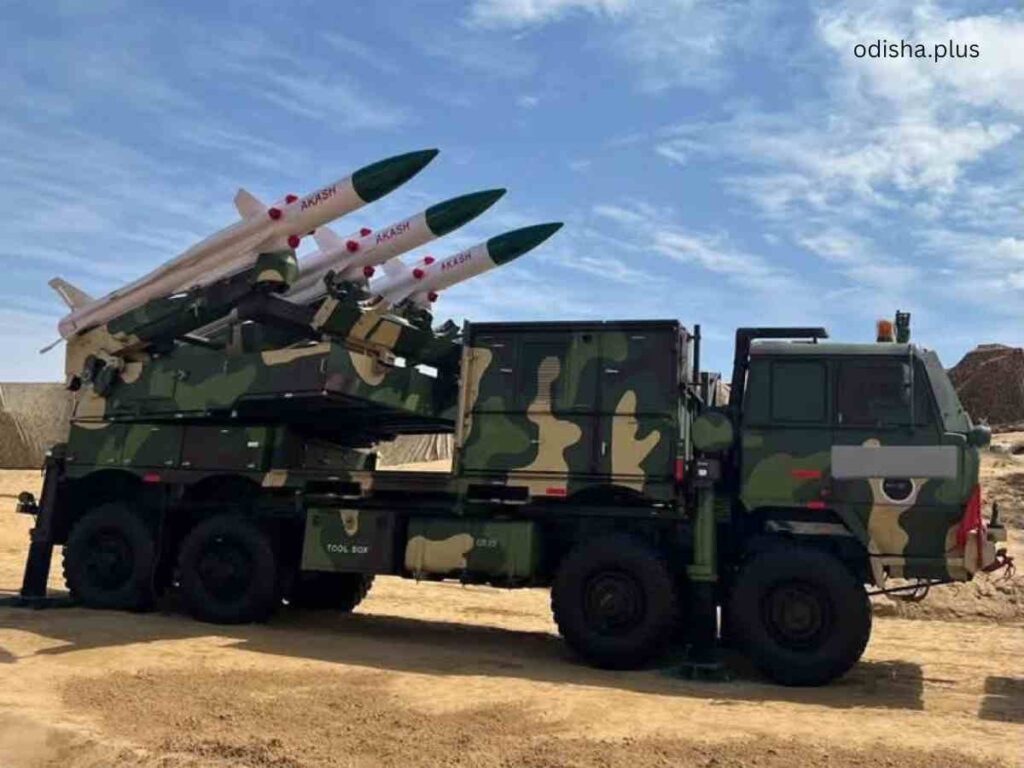The recent successful deployment of the indigenous Akash missile system marks a significant milestone for India’s defense capabilities, underscoring the strategic value of self-reliant technology in modern warfare
Prof. Satya Narayan Misra

The story of indigenous defense technology proving to be a game changer is often inadequately reported. On 7th May, the indigenously developed medium-range Akash missile shot down a PAK JF-17 Thunder, jointly developed with China, in the Kashmir region.
With a 25-45 km intercept range, supersonic speed, and active terminal guidance, this medium-range SAM can engage up to 4 targets simultaneously with 24 ready-to-fire missiles. It has successfully neutralized Pakistan military‘s attempts at large-scale drone and missile attacks on multiple military installations across Northern and Western India during the night of 7-8 May, and the AD system at Lahore was neutralized.
The S400 defense system, popularly called Sudarshan Chakra, imported from Russia, also became a game changer in pulverizing the Pakistani air attacks and destroying the AD systems in different air bases at Rawalpindi and Lahore, as reported.
Russia has been the most stable and potent strategic partner after the 1962 Chinese debacle, with a slew of Technology transfer partnerships, starting with the MiG-21 aircraft in 1963. Be it tanks (T72 & T90), frigates, missiles, or SU-30 aircraft, almost 85% of the defence inventory is sourced from Russia.
In the area of cruise missiles, DrKalam crafted a Joint Venture with Russia, which has since segued into the production of supersonic cruise missiles in the range of 290-800 km, which can be launched from land, ship, air, and submarine.
Undeterred by the USA’s unhappiness, India signed a deal for five S400 squadrons (16 vehicles each) for $5 billion, of which three squadrons have since been received. One squadron is deployed in Srinagar and Pathankot, and one in Rajasthan and Gujarat.
With a range up to 400 km and a speed to engage targets moving at a speed up to 14 Mach, it can engage targets at altitudes up to 56 km. It can engage 80 targets simultaneously and is considered superior to the USA patriot system. China purchased them in 2014 & proving to be the most potent in deflating drone & missile attacks from Pakistan.
The ambitious IGMDP program was overseen by the proud son of India, DrKaam, a confessed votary of self-reliance in niche defence technology, in 1982-83. It has witnessed remarkable success in the successful indigenization and production of Surface-to-Surface Missiles in the range of 150-300 km for all three services. The long-range Agni Surface to Surface Missiles have also been a success.
However, the medium-range Surface to Air Missile AKASH and short-range SAM, Trishul, have been problem children of the overarching program. The problems have been mostly in the guidance systems, where collaboration was sought with France. Though the program started in 1983, the development trials were undertaken in 1997, and it could intercept a live target in 2005.
There has been no looking back on this program since then, with ARDE developing the nuclear warhead, HEMRL the propellant, Tata Power & L &T building the launcher & BEL producing it. It is a successful synergy between developing agencies and public-private partnerships. It is 96% indigenous and very potent against UAVs and aircraft, as demonstrated a few days back at Kashmir.
Countries like the Philippines, Vietnam, Egypt & Brazil have evinced an interest in buying AKASH missiles, who’s upgraded version (AKASH-NG) is in the pipeline. Though long delayed in its fruition, AKASH has demonstrated, we need to be patient with our self-reliance initiatives in critical technologies, where technology denial is possible.
In matters of acquisition of major systems, weapons, and platforms, India has three choices, viz to import (Buy), buy technology and produce at home (Buy & Make), or produce within India out of indigenous technology (Make). While Mirage aircraft and Rafael are now clear examples of Buy, SU-30 aircraft or T72/90 tanks are examples of Buy & Make. In the Make category, we can put LCA or PINAKA as good examples. The Kalam Committee in 1993 had calculated 1993 that India’s Self Reliance Index in critical defence technology was as low as 30%.
The Committee had set a road map to achieve 70% SRI by 2005, through design & development collaboration with reputed global design houses, Joint Ventures with OEMs (Original Equipment Manufacturers), faster absorption of technology, and setting up facilities. It identified certain subsystems like propulsion(engines), weapons (air-to-air missiles), and sensors as bugbears of indigenous capability.
Technologies like Stealth, AESA (Active Electronically Scanned Array) radars, and Focal Plane Array require collaboration. It was thanks to his vision that we have been able to develop AKASH missiles (40 km range) and Medium Range Surface to Air (MR-SAM) missiles (70 km range) in collaboration with Israel.
As the war between India and Pakistan has now been put into a ceasefire, there are several lessons that India can draw from it. It is for the first time that the service officers were trying their hands at completely new systems acquired, like Rafael aircraft from France, High altitude UAVs from Israel, and S-400 from Russia.
India has the dubious reputation of being the second-largest importer of arms, as per the latest SIPRI report. There is a need to up the ante on indigenization, go for more JVs with OEMs, and stitch design & development collaboration with global design houses. Many ill-informed critics point to our inadequate investment in DRDO and ramping up our expenditure from 6% of defense expenditure to 10%.
But as Kalam had intervened before a Defense Standing Committee, the problem is not one of allocation but our deficiency in design capability and lack of depth in advanced fields of defence subsystems in India. All the critical subsystems identified, like Stealth, passive seekers, UAVs, FPAs, AESA radars & laser guided munitions, and air-to-air missiles, RLGs, and GPS, the DRDO track record is rather unenviable.
Besides, while we swear by Make in India, we have shelved the program to get technology from Rafael and build it in India by HAL & Private sector players, and have instead gone for importing the aircraft from France. While placing an additional order for 26 aircraft from Rafael, we have yet again missed the opportunity to get critical technology for the AESA radars and engines from them.
Interestingly USA, which was earlier unwilling to part with niche technology, is willing to transfer technology for building a stealth aircraft, where the Russians are also pitching for D&D collaboration. In this process, we have lost a golden opportunity.
While the Kelkar Committee strongly pitched for PPP in the defence sector and to provide a level playing field to the players, the private sector remains a marginal player. The captive defence PSUs have become more integrators rather than value adders by indigenizing at the component level.
On the contrary, countries like China, which have been availing of technology transfer for aircraft like SU-27 27 have successfully added value and even exported them to other countries like Malaysia. We need to look for design collaboration with reputed design houses and have JVs with OEMs to build our Military Industry Complex, instead of subsidizing foreign arms manufacturers to fight India’s war.
The Rhetoric of Make in India should be realized in practice. War can be a great lesson in the importance of self-reliance in strategic systems, as China has demonstrated to the world.
(The author is a former Director (Finance) of DRDO. Views expressed are personal.)

























